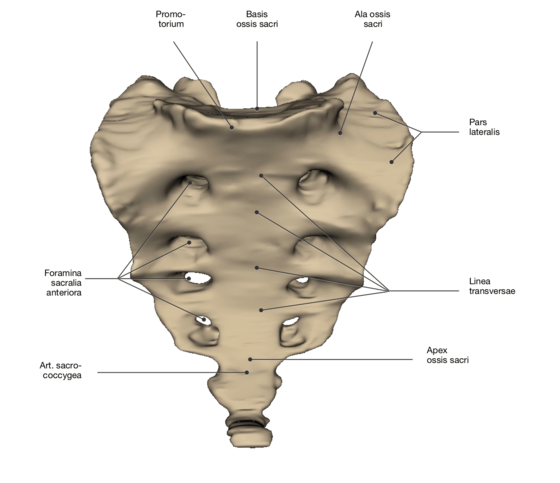Kreuz- und Steißbein/en: Unterschied zwischen den Versionen
Becher (Diskussion | Beiträge) (Die Seite wurde neu angelegt: „* '''''Crista sacralis lateralis''''' (pairwise): formed by the fusion of the transverse processes, runs lateral to the <i>Foramina sacralia posteriora</i>“) |
Becher (Diskussion | Beiträge) (Die Seite wurde neu angelegt: „The spinal canal (<i>Canalis sacralis</i>) ends caudally at the lower opening of the sacrum (<i>Hiatus sacralis</i>). It is caused by the undeveloped fifth ver…“) |
||
| Zeile 30: | Zeile 30: | ||
<br> | <br> | ||
| − | + | The spinal canal (<i>Canalis sacralis</i>) ends caudally at the lower opening of the sacrum (<i>Hiatus sacralis</i>). It is caused by the undeveloped fifth vertebral arch, which lies between the <i>Cornua sacralia</i>. By fusion of the transverse processes the lateral parts of the sacrum (<i>Pars laterales</i>) are formed on both sides, on whose sides the ear-shaped joint surfaces (<i>Facies auriculares</i>) for the iliac bones lie. | |
Version vom 2. Januar 2020, 14:06 Uhr
View from ventral
The sacrum (Os sacrum) is a triangular bone and originally consists of five independent sacral vertebrae (Vertebrae sacrales, S1-S5).
It was formed by the fusion of the five cross vertebrae and the intermediate intervertebral discs (Discus intervertebrales). It belongs to the immobile part of thespine. The sacrum has a forward concave surface (Facies pelvina), the dorsal surface (Facies dorsalis) is convex. The tip of the sacrum (Apex ossis sacri), positioned caudally, is connected to the coccyx. Dorsally of the sacrum, there are five bone ridges (longitudinal ridges), which emerged from the spinous, articular and transverse processes. Between the foramina sacralia anteriora are the four transverse lines of the fused vertebral bodies (line transversae). Furthermore, the passage (Foramina sacralia pelvina) for the spinal cord nerves (spinal nerve) is located there.
The coccyx (Os coccygis) on the other hand consists of three to four rudimentary vertebrae. Only the first coccygeal vertebrae still shows a typical structure of a vertebra. The size of the coccyx decreases distally. From the first coccygeal vertebra arise two bony articular processes, the so-called coccygeal horns (Cornua coccygea). The coccyx also has short transverse processes and is generally connected to the tip of the sacrum by a cartilaginous (Sacrococcygea) process. This enables a passive forward and backward movement of the coccyx. From the age of mid-20, this mobility decreases due to mineralization.
View from dorsal
The uneven, irregular, convex rear surface (Facies dorsalis) has three characteristic mountainous ridges, which can vary in appearance:
- Crista sacralis mediana:
is the union of the spinous processes, which form a serrated bony crest in the middle
- Crista sacralis medialis (pairwise):
laterally formed by fusion of the joint processes
- Crista sacralis lateralis (pairwise):
formed by the fusion of the transverse processes, runs lateral to the Foramina sacralia posteriora
The spinal canal (Canalis sacralis) ends caudally at the lower opening of the sacrum (Hiatus sacralis). It is caused by the undeveloped fifth vertebral arch, which lies between the Cornua sacralia. By fusion of the transverse processes the lateral parts of the sacrum (Pars laterales) are formed on both sides, on whose sides the ear-shaped joint surfaces (Facies auriculares) for the iliac bones lie.
weiterführende Links

